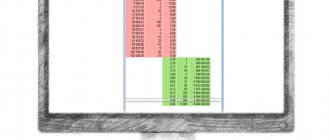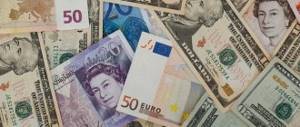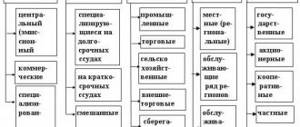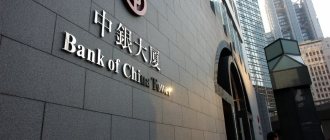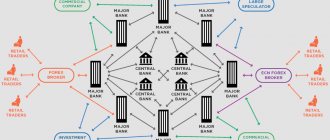08/05/2019 1 309 3 Reading time: 11 min. Rating:
Author
: Konstantin Bely
In this publication I will tell you what the US Federal Reserve discount rate is, what characterizes this indicator, what is its history and dynamics, what happens when the Federal Reserve discount rate increases or decreases, how this affects the exchange rate of the ruble, hryvnia and other currencies . Let's also consider the recent US Federal Reserve rate cut and its possible consequences. So, first things first.
Federal Reserve System
The Federal Reserve System was created to control the country's banking system on December 23, 1913. Until this moment, the entire history of the development of the US banking system can be characterized by an era of complete banking freedom or even an era of complete chaos. Over almost two centuries of history in the United States, there have been attempts to create central banks, but since more than half of them were private, their activities were exclusively built on serving the interests of the owners and were contrary to the interests of the country. That is, they did not serve as a full-fledged central regulator. In the absence of centralization of the banking sector, the United States experienced 4 economic crises, the last of which was in 1907. All this prompted the US government to carry out a number of reforms in the banking system, which ultimately led to the creation of the FED.
Currently, the Federal Reserve System is a rather complex structure, which is a joint-stock company with private owners. The structure of the Federal Reserve System is formed by 3 key entities:
Board of Governors of the Federal Reserve System
- an agency of the federal government that reports to and is directly accountable to Congress. It provides overall management of the system and oversees the 12 reserve banks. The seven members of the Board of Governors are appointed by the President and confirmed by the Senate.
12 Federal Reserve Banks.
When the Federal Reserve was created, the United States was geographically divided into 12 districts, each of which created a separate Reserve Bank. District boundaries were based on the predominant trading regions of the 1913 period, meaning they do not coincide with state boundaries. The districts operate independently but under the supervision of the Federal Reserve Board of Governors. The activities of reserve banks are centralized through the conclusion of intra-system agreements.
Federal Open Market Committee (FOMC)
— makes decisions that promote the health of the U.S. economy and the stability of the U.S. financial system. It consists of twelve members. The FOMC holds 8 regular meetings per year at which it reviews current economic and financial conditions, determines the appropriate monetary policy stance, and assesses risks to its long-term goals of stability and sustainable economic growth.
Functions of the Federal Reserve
The Fed acts as the main regulator of the US economy and the guarantor of the stability of the financial system. The functions of the Federal Reserve are prescribed by the Federal Reserve Act.
Key functions of the Fed:
- Performing the functions of the Central Bank is the development of the banking system, issuing currency, ensuring the uninterrupted operation of the financial system, maintaining a balance between the interests of banks and the government.
- Regulation of the economy through monetary policy, in particular by changing the discount rate, the quantitative easing program, etc.
- Supervision and regulation of banks - monitoring by the Federal Reserve of banking operations and transactions, monitoring compliance with legislative acts.
- Preventing problems of monetary liquidity - carrying out repurchases of securities to provide the economy with the necessary money supply
- Participation in the domestic and international payment system.
- Protecting the interests of consumers of banking services - supervision of compliance with legislation by banking organizations in relation to their clients.
- Storing gold and foreign exchange reserves – storing gold in the form of physical bullion in your vaults.
One of the functions of the Fed is also the issue of the national currency of America. The Fed has even been given this unspoken status in the world—a “private printing press” on a planetary scale.
The FED is responsible for setting the discount rate, inflation regulation and targeting, and also determines the country's overall economic policy.
The Federal Reserve System, as a regulator of the economy, can also take drastic measures to support it in cases of crisis situations. Using various monetary policy instruments, the FED can influence the economic situation in the country through their application. It was their use that supported stock markets during the crises of 2008 and 2021, preventing them from declining further.
Fed tools and their impact on the market
The Federal Reserve regulates the US economy through various monetary policy instruments. The key ones are:
- Fed rate.
- Open market operations.
- Reserve requirements for banks.
Each of their instruments is in the zone of influence of a specific structural link of the regulator. The Federal Reserve Board is responsible for the policy rate and reserve requirements, and the FOMC is responsible for open market operations. The use of any of these instruments triggers a chain of events that affect foreign exchange rates, long-term interest rates, the amount of liquidity and credit in the economy, etc. That is, on a range of economic variables, including labor market indicators, output and prices of goods and services. Let's look at each of the tools in more detail.
FEDWatchtool and BoEWatchtool tools: how to use them
In order to use these tools you need to have some basic skills. Ability to read tables and graphs, as well as use the proposed tools; Understanding the principle of probability distribution of investor expectations; Ability to compare tables, graphs and changes in information on them in the long term.
Fed rate
The Fed rate (you can learn more about it in our article “What the Fed rate affects”) is an interest rate that is the main instrument of US credit policy, on the basis of which the cost of loans issued to banking organizations is determined. The Fed determines the interest rate based on the current and forecast macroeconomic situation in the country.
A change in the discount rate affects all financial markets of the country. At the same time, the size of the bet has a different effect on different markets. For example, the impact on the foreign exchange market is that the higher the discount rate, the better the returns in dollars become than in currencies with a lower rate. The impact of the rate on the bond market is most obvious - the higher the rate, the higher the bond yield, and vice versa.
As for the stock market, the lower the rate, the more attractive it is for investors. This is due to the fact that low interest rates reduce the cost of borrowing for businesses. This factor makes it easier to service loans and allows you to improve your financial performance, which leads to an increase in stock prices of individual companies and, in general, the capitalization of the entire market.
The low Fed rate for the US economy is a kind of growth driver - thereby the Fed reduces its lending rate so that cheaper loans stimulate investment in production, increased employment and wages, healthy demand, normal inflation of 2 percent, etc. If you look at the graph of the historical dynamics of the regulator’s rate, you can just note that during crises there are sharp changes in interest rates.
Thus, to support the market during the global financial crisis of 2008, the discount rate was sharply reduced from 5.25% to 0.25%, and during the coronavirus crisis period of 2021 - from 1.75% to 0.25% and remains at this level from March 16 of the previous year.
Open market operations
They involve buying or selling Treasuries on the open market. These operations allow you to increase or, conversely, decrease the total money supply in the economy. Purchasing or repurchasing treasury bonds, this process is also called Quantitative easing (QE or quantitative easing) - a monetary policy tool used to stimulate the state’s economy. As a result of these operations, the level of monetary liquidity increases, since bonds are “exchanged for money.” To purchase securities, funds are issued in non-cash rather than physical form, that is, without turning on printing presses and increasing the “paper” supply of money. This measure is usually used when interest rates are low as a last resort.
Quantitative easing was first used in 2009, when the FED bought back assets worth about 1.7 trillion. dollars, and in 2010 another buyout program was launched - QE 2 - for another 600 billion dollars. These measures were taken to revive the economy and financial markets after the 2008 crisis, and they had a positive impact. And on March 15, 2021, the Fed launched the QE 4 program. At the same time, it was announced that Treasury bonds and mortgage-backed securities would be repurchased to the extent necessary to maintain stock markets and a high level of liquidity, without setting a limit on the volume of repurchase . This is the largest asset repurchase program in the history of quantitative easing, which, together with other factors, has had a positive effect on the financial system.
There is a process that is the opposite of quantitative easing - the sale of government bonds to the market. Such actions lead to a reduction in the money supply, as money is removed from the economy by exchanging it for bonds. And at the same time this leads to an increase in public debt. Buyers of debt securities include foreign central banks, governments, companies, commercial banks, bond funds, other funds and individuals.
Open market operations are a subtle tool for influencing interest rates. When the Fed buys bonds, prices are pushed up and interest rates are lowered. If the Fed sells bonds, it pushes prices down and rates go up. Since late 2008, the regulator has significantly expanded its holdings of securities through open market purchases to put pressure on long-term interest rates and thereby support economic activity and job creation by creating more favorable financial conditions.
An indicator of what policy the Fed is pursuing in the open market, buying or selling government securities, is the Fed's balance sheet
. The Fed's balance sheet represents the regulator's own balance sheet of assets and liabilities. Statistics on it are compiled weekly, information is published in the public domain on the Federal Reserve website. In 2021, FED assets increased almost 1.5 times - from 4.174 trillion. dollars to 7.411 trillion. dollars, with the bulk of the increase occurring in March-April 2021. The growth in the balance sheet is precisely due to the fact that securities were repurchased from the market (approximately 3.2-3.3 trillion dollars). The Fed flooded the system with liquidity and bought many assets onto its balance sheet. Such actions reduce excess selling pressure and help support markets and the economy as a whole.
There is a direct correlation - if the Fed balance sheet increases, then US stock indices (in particular the S&P500) go up. Conversely, a shrinking balance sheet has a negative impact on equity markets.
Learning to read a chart
Here is a print screen of the page and now we will analyze the meanings of all the buttons we need.
I have highlighted with red rectangles the areas that are most important to us.
At the top we see a menu with links to expectations for the next 8 meetings. Literally tomorrow (June 19) the next meeting will be held, so we will learn from it, as well as from the expectations for the meeting on July 31. On the left we see a menu in which I will describe the following buttons: current, compare, probabilities, historical. By and large, most readers will only need the current button. In the Meeting information section we see all the information on the futures with which calculations of rate expectations are associated. In general, this information makes us neither cold nor hot. But the Probabilities section is very useful. Essentially, it condenses the information presented in the graph. By “compressed” I mean the following. There are only three options in the table: decrease, no change and increase. And there may be more options on the chart, because... a reduction is possible by 0.25% or 0.5% points.
Here, for example, are the expectations for the July meeting. Now we see that the probability of decline is 83.7%. That's a lot. But how are these expectations really distributed? After all, we read just yesterday or the day before that Goldman Sachs denies a sharp reduction in rates. On the graph we see that with a probability of 64.7% there will be a decrease of 0.25%, which is the minimum step. And the “sharp” decrease, i.e. by 0.5% at once, can only happen with a probability of 19.0%. This probability, by the way, is actually equal to the probability of leaving rates unchanged on July 31 (16.3%). The same information is presented in the table below the graph, which we will analyze in detail below. After the Probabilities section, we should look at the graph. But we have already sorted it out for you. Each bar is the probability of a particular event. I think there is no need to explain further. Let me just remind you once again that for a simple understanding of the situation, it is necessary to monitor how much the probability of a general change in the rate is higher than the probability of keeping it unchanged. The most interesting situation is when the market expects a change, but the size of the change is not clear. It is in such situations that sharp movements in the market occur. In general, tomorrow the rate will not change in any way, but in July they will change, unless something changes in 1.5 months. But the probability is small. Below the graph there is another table. The first column (target rate) indicates the ranges of rates that are somehow relevant at this meeting. And the next 4 columns show data for bets on the current date, 1 day before the current date; a week and a month before the current date. Thus, this table allows you to analyze the dynamics of expectations for changes in the Fed rate. The figure dedicated to the July meeting clearly shows that over the course of a month the expectations changed to the exact opposite, i.e. there was a reversal of expectations. There are still 1.5 months until the July meeting, which will include the June meeting, the G20 meeting and a number of other events, the sum of which may change expectations in one direction or another. So you need to monitor expectations at least once every two weeks in order to be in the same information field with real financial sharks.
It's time to move on to the next sections of the left menu. Click on the Compare button and get the following graph for the current rate. What is he showing us? Basically, nothing new. This is simply a graphical table of expectations from today, yesterday, a week and a month ago. In general, everything is simple and clear. Once again, I recommend assessing how dramatically expectations for the July meeting have changed over the past month.
The next link in the menu is Probabilities. This is a fairly informative table with the distribution of bet probabilities for the next 8 meetings, i.e. a year in advance. Naturally, the probabilities of changes in rates change, but if you correctly understood the mandate of the Fed, on the one hand, and the principle of calculating these probabilities, on the other hand, then this table will show you the REAL EXPECTATIONS OF A LARGE TRANSNATIONAL BUSINESS on the prospects of the American and world economy. Now the expectations are that at the end of the year the rate will be 0.5%, and maybe even 0.75% lower than the current one. All clear?
The last two links we are interested in are Historical and Downloads. By clicking on the first link and selecting the meeting of interest (July 31, since the rate will most likely be reduced there), you can see the change in expectations for the rate for this meeting over the year.
Remember what we had there in the first third of December 2021? Don't remember? In vain, you need to remember such things if you are engaged in trading on the stock exchange. Then the stock market crashed and in general everything was bad. And that's when the markets reacted with a sharp change in expectations. But the Fed hasn’t said anything concrete yet, and even hinted at an increase. Do you remember about the thermometer? Well, this is it. In general, at this time investors completely forgot about raising rates, but from mid-March they began to think about lowering them.
But just the other day (since the end of May) there was no longer any talk of keeping the rate unchanged. Isn't that interesting? Let's move on to the last link we are interested in - Downloads. This is essentially the same as the Historical link, only here you can download this information in a convenient format and analyze it the way you need. Do you need it? I don't think so. But monitoring expectations is more than enough.
Reserve requirements
The Federal Reserve Board sets reserve requirements for banking institutions. Reserve requirements are established as a percentage of each type of deposit in a bank and are introduced in order to limit the lending capabilities of banks. The higher the reserve, the less money the bank has to lend per dollar deposited. For example, if the reserve requirement is set at 5% and a bank receives a deposit of $500, it can issue a loan for $475 of the deposit amount since it only needs to hold $25 or 5% in reserve. The current situation in the United States is such that from March 26, 2021, the regulator reduced reserve requirements to 0%, essentially eliminating reserve requirements for all depository institutions. This measure resulted in a reduction in required reserves by approximately $200 billion. Whether this measure will be temporary or permanent, time will tell.
Key Fed Reports
The Federal Reserve System reports on its activities by publishing reports. Investors always monitor the release dates of reports, since the information contained in them has a direct impact on the stock market index curve.
Monetary Policy Report.
The regulator submits it to the US Congress once every six months. The report is also sent to the Senate Committee on Banking, Housing and Urban Affairs and the House Committee on Financial Services. The report consists of three parts. The first contains a financial and economic assessment of the conditions affecting the US dollar, a description of the labor market situation, inflation infographics, GDP dynamics and an assessment of the banking sector. The second part contains a detailed description of monetary policy with an assessment of its current effectiveness, as well as an overview of the dynamics of changes in short-term interest rates. The measures of the quantitative easing program, the Fed's balance sheet of assets and liabilities, and the state of the country's government reserve are described. The third part presents forecasts for inflation expectations, unemployment levels and the direction of development of the national economy.
In this report, investors primarily pay attention to forecasts for the discount rate, data on inflation and GDP dynamics. The latest report on monetary policy can be found on the regulator's website.
Minutes of the Fed meeting.
The minutes are published after each meeting held by the regulator and contain information that was available to the meeting participants. In addition to detailed information about the current decisions made regarding monetary policy - the Fed rate, the policy of actions on the open market, the protocol reflects the rhetoric of the future course. Therefore, investors study it closely to track future changes in interest rates. The minutes are published 3 weeks after the meeting on the Fed website.
Additional reports of forward value are the trilogy of documents - Beige, Green and Blue Books. They are named according to the color of the document cover.
Beige book
- a report on the current situation in the economy for twelve federal districts of America, which gives an idea of the trends and directions in the economy for each of them. It is released eight times a year, half a month before the Federal Open Market Committee (FOMC) meeting. In fact, the material in the document serves as the basis for the Fed to adopt a further course of monetary policy. Positive trends in the economics of the districts may become the basis for a strengthening of the US dollar, and negative ones - for a weakening of the national currency. The reports can be viewed by following the link. The Beige Book is the only report that is published publicly on the Federal Reserve's website.
Green book
is a national two-year forecast produced by the Economic Research and Statistics Division of the Board of Governors. This report is prepared for members participating in the FOMC meeting.
Blue book
– a report that is also prepared for the FOMC meeting. It provides a forecast for monetary policy and presents a consideration of three different options for future monetary policy.
What is a discount rate: simple about the complex
What is a discount rate? This is the interest rate at which the Central Bank funds commercial banks. In theory, and in practice too, usually, a reduction in the rate stimulates lending, while an increase, on the contrary, slows it down. Increased lending increases economic activity, which can lead to higher inflation and accelerated depreciation of money. Therefore, the policy of the Central Bank is as follows: a decrease is replaced by an increase, which is replaced by a decrease. In general, a conventional system with regulatory feedback. The cistern in the restroom is also installed. Below I will show how it works. Every time you press the toilet button, the inlet valve inside opens. The water leaves faster than new water comes in, so the valve opens more and more until all the water is gone. When interest rates are high, there is no influx of fresh money, the economy stagnates, because... it is difficult to expand production and stimulate demand. But as soon as the Central Bank lowers the toilet button, I meant to say they lower the rates, then the influx of new cheap money immediately begins. When all the old water has gone, new water arrives with great force, because... the valve is fully open. At this time, we are seeing financial bubbles in the economy, lending to everyone and everything, and there is more than enough money. In general, rates are low – economic activity is growing, and with it inflation. The water in the tank gradually rises, which means that rates in the economy begin to rise, i.e. the valve closes. The economy is slowing down, and so is the flow of water. The water has risen, the valve has closed: the rate is at its maximum, the economy needs cheap money; enterprises are suffocating without loans. The time has come to reduce the rate, i.e. drain the water again. And so every time.
I hope this simple comparison has helped to understand how the countercyclical policies of Central Banks work. Of course, everything is a little more complicated (for example, the flow of water during the drainage process increases for some time, and the Central Bank, in turn, reduces the rate for some time, i.e. this is a pro-cyclical policy), but we don’t need to know more. I hope I explained quite popularly how the Central Bank regulates economic activity through the rate.
conclusions
The Fed is a very important part of the American and entire world economy. The main function of the regulator is to maintain the stability of the financial system. And to achieve this goal, the Fed uses a set of tools. By changing the value of the discount rate, the volume of operations on the open market, as well as through the policy of establishing reserves for banks, the regulator stimulates the country's economy, directing it in the desired direction of development and takes emergency measures in the event of serious crises.
But despite the fact that financial regulators keep markets afloat in crisis situations, when investing you should not rely recklessly on the actions of regulatory organizations. You should always remember that only smart investing with competent risk management can allow you to make stable profits not only on a growing, but also on a falling stock market. Our Radar service can help you select suitable assets.
If you need to get more detailed information about investing, you can attend one of our open free webinars. You can sign up for it using this link.
Good luck with your investment!
What's on the Bank of England's agenda?
The day after the Fed meeting there will be a meeting of the Bank of England. I won't say anything about him. Just follow the link to BoEWatchTool that I gave above, or find this link yourself and look at investors’ expectations for the rate. When and how is the Bank of England policy expected to change? That's it. Oh, and be sure to watch for changes in expectations after Thursday's meeting.
